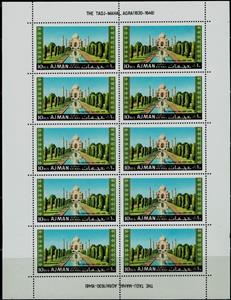Full Pane: The Tadj-Mahal-Agra (1630-1648) Indian Art - Mogul Period (Ajman 1967)
The Tadj-Mahal-Agra (1630-1648) Indian Art - Mogul Period (Ajman 1967)
30 September (Ajman ) within release Tadj-mahal goes into circulation Full Pane The Tadj-Mahal-Agra (1630-1648) Indian Art - Mogul Period face value 10*10 United Arab Emirates riyal
| Full Pane The Tadj-Mahal-Agra (1630-1648) Indian Art - Mogul Period in catalogues | |
|---|---|
| Colnect codes: | Col: AJ 1967.09.30-1b |
Full Pane is square format.
Full pane not mentioned by MichelAlso in the issue Tadj-mahal:
- Stamp - Tadj-Mahal; Agra (1630-1648) face value 10;
- Souvenir Sheet - Taj Mahal - Agra (1630-1648) face value 10;
- Stamp - Taj Mahal, Agra (1630-1648) face value 10;
- Stamp - Taj Mahal, Agra (1630-1648) face value 10;
- Full Pane - The Tadj-Mahal-Agra (1630-1648) Indian Art - Mogul Period face value 10*10;
- Souvenir Sheet - The Tadj-Mahal-Agra (1630-1648) Indian Art - Mogul Period face value 10;
Full Pane The Tadj-Mahal-Agra (1630-1648) Indian Art - Mogul Period it reflects the thematic directions:
Architecture (Latin architectura, from the Greek ἀρχιτέκτων arkhitekton "architect", from ἀρχι- "chief" and τέκτων "builder") is both the process and the product of planning, designing, and constructing buildings and other physical structures. Architectural works, in the material form of buildings, are often perceived as cultural symbols and as works of art. Historical civilizations are often identified with their surviving architectural achievements.
A building or edifice is a structure with a roof and walls standing more or less permanently in one place, such as a house or factory. Buildings come in a variety of sizes, shapes and functions, and have been adapted throughout history for a wide number of factors, from building materials available, to weather conditions, to land prices, ground conditions, specific uses and aesthetic reasons. Buildings serve several needs of society – primarily as shelter from weather, security, living space, privacy, to store belongings, and to comfortably live and work. A building as a shelter represents a physical division of the human habitat (a place of comfort and safety) and the outside (a place that at times may be harsh and harmful).
A mausoleum is an external free-standing building constructed as a monument enclosing the burial chamber of a deceased person or people. A mausoleum without the person's remains is called a cenotaph. A mausoleum may be considered a type of tomb, or the tomb may be considered to be within the mausoleum.
The United Nations Educational, Scientific and Cultural Organization (UNESCO; pronounced /juːˈnɛskoʊ/) is a specialized agency of the United Nations (UN) with the aim of promoting world peace and security through international cooperation in education, arts, sciences and culture. It has 194 member states and 12 associate members,as well as partners in the non-governmental, intergovernmental and private sector. Headquartered in Paris, France, UNESCO has 53 regional field offices and 199 national commissions




